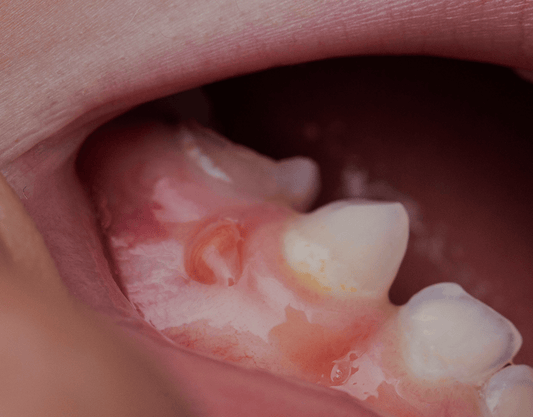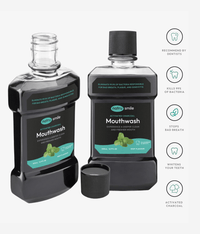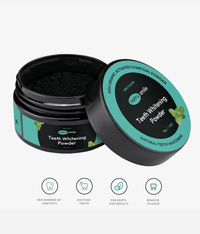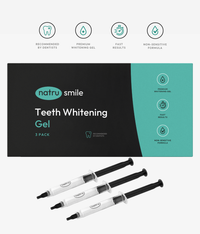
All products are certified by dental expert Dr. Greg Grillo
Introduction To Gum Boils And Their Nature
A gum boil, commonly referred to as a dental abscess or periodontal abscess, is a localized accumulation of pus that typically results from a bacterial infection in the gum or dental tissue. Gum boils often manifest as painful bumps or swellings on the gums, which can cause significant pain and discomfort.
There is a wide range of factors that can contribute to the development of gum boils, and they can be categorized into various types based on their origin and severity. Treatment options for gum boils span from at-home care and remedies to professional dental interventions.
A Closer Look At Gum Boil Causes
Gum boils can develop due to various causes, ranging from poor oral hygiene to dental trauma. Some contributing factors include:
- Poor oral hygiene: Insufficient or improper oral care, such as irregular brushing and flossing, can result in a buildup of plaque and bacteria, leading to infection and the formation of gum boils.
- Gum disease: Advanced gum disease, or periodontitis, can cause the teeth to pull away from the gums, creating pockets that allow bacteria to infiltrate and infection to occur.
- Dental decay: Tooth decay can go beyond damaging the enamel and dentin, allowing bacteria to access the pulp and create an abscess.
- Cracked or broken teeth: Physical trauma like cracked or broken teeth can expose the interior of the tooth, making it susceptible to infection and abscess formation.
- Impacted teeth: Teeth that are unable to fully erupt, such as wisdom teeth, can create pockets of infection and inflammation, which can develop into a gum boil.
Gum Boil Pictures
It is essential to understand what gum boils look like and how they might present. Gum boils generally manifest as minor, fluid-filled bumps on the gums; these are often red, inflamed, and may appear swollen. Should you need a visual aid, an internet search for "gum boil" will provide you with numerous examples to help you visualize this condition more precisely.
Based on their location and origin, gum boils can be categorized into types.
Types Of Gum Boils
There are three primary categories of gum boils, each deriving from a different cause and affecting unique areas of the mouth:
- Periodontal (gum) abscess: This type of gum boil occurs in the gums surrounding a tooth and is usually triggered by factors such as poor oral hygiene, gum disease, or infections. People with a periodontal abscess may experience symptoms such as pain, inflammation, and a build-up of pus in the affected region.
- Periapical (tooth) abscess: A periapical abscess arises at the tip of a tooth's root and is most commonly caused by tooth decay, cracks in the tooth, or the failure of dental treatments such as root canals. Periapical abscesses may cause severe gum pain, especially when chewing or applying pressure, and are often accompanied by symptoms like fever, sensitivity, and swollen lymph nodes.
- Combined periodontal-endodontic abscess: This form of gum boil results from a combination of the two types listed above. A combined periodontal-endodontic abscess occurs when an infection spreads from the gums to the tooth or vice versa. The symptoms and severity of this abscess depend on the nature of the underlying infection and may encompass aspects of both periodontal and periapical abscesses.
Each type of gum boil requires different treatment approaches, making it imperative to identify the root cause and eliminate the source of infection to resolve the issue effectively.
Symptoms Of Gum Boils
Gum boils, also known as abscesses, can manifest in various ways and cause several uncomfortable symptoms. Some of the most common signs and symptoms of gum boils are as follows:
Pain Or Discomfort
One of the primary symptoms of gum boils is pain or discomfort in the affected area. This is often localized around the boil itself and can intensify when biting or applying pressure to the tooth. Depending on the severity of the boil, this pain may be mild or incredibly severe, requiring medical intervention for relief.
Persistent Bad Breath
Another symptom associated with gum boils is persistent bad breath (halitosis) or a constant foul taste in the mouth. This unpleasant odor or taste is usually caused by the presence of pus or an infection in the gums. Regular oral hygiene practices like brushing, flossing, and using mouthwash may not be sufficient in alleviating the issue until the underlying cause is addressed.
Gum Bleeding
Gum boils can also result in spontaneous or provoked bleeding from the gums. This bleeding might result from actions like brushing, flossing, or even eating certain foods. Regularly experiencing gum bleeding could signal a gum boil or another underlying dental issue.
Pus Discharge
With gum boils, pus or blood may be present in the mouth, causing a distinctly unpleasant taste or odor. The discharge of pus typically indicates that an infection is present, and it may be particularly noticeable after applying pressure to the boil or gum area.
Earache
An earache may occur if the infection from the gums spreads to nearby areas, such as the ear. This type of pain can be quite uncomfortable and may be accompanied by other symptoms like a fever or dizziness. If you experience an earache alongside other gum boil symptoms, it's crucial to seek dental care promptly.
Overall, recognizing the symptoms of gum boils is essential for proper diagnosis and treatment. If you suspect you have a gum boil, don't hesitate to reach out to your dentist or dental professional for guidance on what to do next.
Swollen Gums
One of the potential symptoms associated with a black dot on the tooth could be inflammation or swollen gums surrounding the tooth. This may present as red, swollen, or tender gum tissue around the black dot or even extending to the adjacent gum areas.
Sensitivity To Hot Or Cold
Another symptom that people with black gums or a black dot on their teeth might experience is heightened sensitivity to hot or cold foods or beverages. This increased sensitivity occurs due to inflammation in the gums or possibly due to the black dot affecting the enamel or dentin layers of the tooth, which can expose the inner nerve, causing discomfort when coming into contact with different temperatures.
Nausea
Nausea or vomiting is yet another possible symptom that might be connected to a black dot on the tooth. This unpleasant sensation or feeling of needing to vomit could be a result of swallowing pus from an infected area associated with the black dot, or it might stem from experiencing a fever due to an underlying infection caused by the presence of the black dot.
Fever
A fever, or an increase in body temperature, can sometimes be a symptom of a black dot on the tooth. This temperature rise is a result of the body's immune response to an infection caused by bacteria or other microorganisms related to the black dot. A fever may also signal the need for immediate medical attention as it might be indicative of a more severe infection or an abscess, which could lead to further complications if left untreated.
Home Care And Natural Remedies For Black Dots On Teeth
If you want to try natural remedies and home care techniques to address black dots on your teeth, there are several options available. While professional dental care is always the best option when dealing with any dental issue, the following suggestions may help provide temporary relief or early intervention for black dots.
Rinsing With Saltwater
One of the simplest and most effective remedies is to rinse your mouth with a warm saltwater solution. To do this, dissolve 1/2 teaspoon of salt in 8 ounces of warm water. Swish the solution in your mouth for about 30 seconds to one minute and then spit it out. This can help alleviate pain, bring down inflammation, and promote the healing process. It is safe to rinse multiple times a day until the issue is addressed by a professional.
Rinsing With Hydrogen Peroxide
Another useful home remedy for treating black dots on teeth is to rinse with a solution of hydrogen peroxide. Make sure to use a 3% hydrogen peroxide solution, and dilute it with an equal amount of water. This can help disinfect the affected area and may effectively kill bacteria that could be contributing to the black dot's development. After swishing the mixture in your mouth for about a minute, spit it out, and rinse with plain water. It's essential not to swallow the solution and limit its use to once a day.
Applying Tea Tree Oil To The Affected Area
Tea tree oil is known for its potent antibacterial properties, making it a potential treatment option for combating infections associated with black dots on teeth. To use tea tree oil safely, dilute a few drops of the essential oil in coconut or almond oil. Dab a clean cotton swab or Q-tip into the oil mixture and carefully apply it to the area around the black dot. Do not ingest the oil, and remember never to use it undiluted, as it can cause irritation and other side effects.
Rinsing With Garlic Juice
Garlic is a popular natural remedy for various ailments, thanks to its strong antimicrobial properties. You can use garlic juice as a home remedy for black dots on teeth by crushing a few garlic cloves to extract the juice. Dilute the juice in some water and use it to rinse your mouth, taking extra care to swish the mixture around the affected area. Garlic juice can potentially help fight off infection and provide some temporary relief. You can repeat this method once or twice daily.
Please remember that these home remedies might bring temporary relief, but it is essential to consult a dental professional for a thorough examination and appropriate treatment plan for any dental issue, including black dots on teeth.
Good Oral Hygiene: The Foundation Of A Healthy Mouth
One of the most effective ways to prevent gum boils and promote a speedy recovery is to maintain good oral hygiene. This involves several key steps to keep your teeth and gums in top shape:
- Brushing: Brush your teeth at least twice a day, using a soft-bristled toothbrush and fluoride toothpaste. Ensure that you thoroughly clean all surfaces of your teeth and brush for at least two minutes each time.
- Flossing: Floss daily to remove plaque and food particles from between your teeth and under the gumline. This helps to prevent the buildup of bacteria that could lead to gum boils and other dental issues.
- Using an antiseptic mouthwash: Rinse your mouth with an antibacterial mouthwash after brushing and flossing. This can help to kill any remaining bacteria and further prevent gum boil formation.
No Smoking: Protect Your Gums, Teeth, And Overall Health
Tobacco smoke can disrupt the natural balance of bacteria in your mouth, increasing the risk of gum infections and impeding the healing process. By quitting smoking, you'll not only increase your chances of effectively managing gum boils, but you'll also improve your overall oral health and reduce your risk of various other dental problems.
Turmeric Paste: A Natural Remedy For Gum Boils
Turmeric, a spice commonly used in cooking, has several health benefits, including antibacterial and anti-inflammatory properties. These properties can help to soothe a gum boil and promote healing. To make a turmeric paste for gum boil relief, follow these simple steps:
- Mix a small amount of turmeric powder with water until it forms a thick paste.
- Apply the turmeric paste directly to the gum boil, ensuring that you cover the affected area completely.
- Leave the paste on for about 15-20 minutes, allowing the turmeric's natural healing properties to work.
- Rinse your mouth gently with warm water to remove the paste and any residual bacteria.
Remember that, while turmeric paste might provide temporary relief, it's essential to consult your dentist if the gum boil persists or worsens. They can help determine the underlying cause and recommend appropriate treatment options.
Gum Boil Dental Treatments: Overview And Procedures
A gum boil, also known as a dental abscess, may develop in your oral cavity if your dental health is compromised. Fortunately, there are several treatments available to combat and resolve gum boils. In this section, we'll explore the various dental treatments to address this issue.
Prescribed Antibiotics For Treating Bacterial Infections
If a dental professional determines that the gum boil is caused by a bacterial infection, they may prescribe a course of antibiotics to help clear the infection. Antibiotics assist your immune system in combating harmful bacteria and may resolve the gum boil within a few days or weeks, depending on the severity of the infection. Remember to take your antibiotics as prescribed, and finish the entire course to prevent antibiotic-resistant bacterial strains from developing.
Deep Cleaning For Those With Unhealthy Gums
Dentists often recommend a deep cleaning procedure, also known as scaling and root planing, for patients with unhealthy gums, as it can effectively remove plaque, bacteria, and tartar below the gum line. In doing so, this treatment helps to reduce inflammation, promote gum health and prevent the development of gum boils.
During a deep cleaning procedure, your dentist or dental hygienist will first use a scaler to remove plaque and tartar from your teeth and beneath your gum line. Next, they'll perform root planing, which involves smoothing the tooth's root surfaces to prevent plaque and bacteria from easily accumulating again. By promoting gum attachment and reducing inflammation, deep cleanings can be a vital component in the recovery from gum boils and general gum health.
Root Canal For Tooth Decay Or Damage
In cases where a gum boil is caused by tooth decay, damage, or infected dental pulp, your dentist may recommend a root canal treatment to resolve the issue. A root canal procedure involves removing the infected, diseased, or dead dental pulp and nerves from the tooth, cleaning the interior chambers and root canals, and sealing the tooth with a biocompatible material to prevent further infection.
To complete the process, your dentist may place a crown or other restorative material on top of the tooth to protect it and restore its function. Root canal treatments are immensely helpful in preventing tooth loss, reducing pain and sensitivity, and saving a damaged tooth from extraction.
In summary, identifying and treating gum boils is a crucial aspect of maintaining optimal dental health. By understanding the different treatments offered by dental professionals, you can make well-informed decisions about your oral care and potentially avoid more severe dental complications down the line.
Boil On Gum After Root Canal, Is That Normal?
A gum boil, also known as a dental abscess or periapical abscess, may occasionally appear after a root canal procedure, though it is not considered normal. This post-root canal complication can develop if there is any residual infection present within the tooth or if the dental pulp was not entirely removed during the procedure. In such cases, the gum boil may serve as an indication that the root canal treatment was not entirely successful or that additional treatment is required to fully address the issue.
If you notice a gum boil following a root canal, it is essential to get in touch with your dentist as soon as possible. Your dentist can evaluate the situation and determine the appropriate course of action, which may include prescribing antibiotics, scheduling additional dental procedures, or providing further instructions for at-home care.
Gum Boils After Tooth Extraction, Is That Normal?
Though gum boils are not prevalent or expected after tooth extraction, they can still occur in certain situations. These boils can develop if bacteria find their way into the extraction site, leading to an infection known as a post-extraction dental abscess. Pain, swelling, and discomfort at the extraction site are usually associated with this type of infection.
As with gum boils after a root canal, it is crucial to inform your dentist if you encounter a gum boil following a tooth extraction. This will ensure that the infection is addressed promptly and properly, preventing complications and promoting a smooth recovery process. Your dentist may recommend specific care and treatment options tailored to your situation, such as prescribing antibiotics, applying a warm compress, or conducting additional dental procedures if necessary.
What Does A Gum Boil Look Like?
A gum boil, also known as a dental abscess or a parulis, is a dental infection that usually manifests as a swollen bump on the gums. This bump may appear red or purple, depending on the severity of the infection and the individual's skin tone. Additionally, the bump may be filled with pus and accompanied by inflammation of the surrounding gum tissue. The area may be sensitive, tender, or even painful to touch, which can result in discomfort while eating, drinking, or brushing your teeth.
Is A Gum Boil An Emergency?
While the gum boil itself does not necessarily constitute a dental emergency, the underlying dental infection can potentially progress to more severe complications if left untreated. These complications may include the spread of infection to surrounding tissues, bones, and even other areas of the body, such as the bloodstream or the brain.
Due to the potential risks associated with an untreated dental infection, it is important to monitor your symptoms and seek professional dental care as soon as possible. If you notice any of the following symptoms alongside your gum boil, it may be necessary to seek immediate medical attention:
- Intense or persistent pain that is not alleviated by over-the-counter pain relievers
- High fever that may be accompanied by chills or fatigue
- Difficulty breathing or swallowing
- Swelling of the face, neck, or mouth that continues to worsen
- Signs of spreading infection, such as warmth, redness, or the development of adjacent pus-filled bumps
In summary, a gum boil is not necessarily an emergency on its own, but the symptoms and potential complications it presents warrant prompt evaluation and treatment from a dental professional.
Does A Gum Boil Indicate Infection?
A gum boil, or a dental abscess, often indicates the presence of a bacterial infection in either the gum tissue or the tooth's root. Dental abscesses typically form as a result of poor dental hygiene, tooth decay, or gum disease, which allows harmful bacteria to infiltrate and cause infections.
Can Stress Lead To Gum Boils?
While it is unlikely that stress alone directly causes gum boils, it's essential to note that stress can adversely impact the body's immune system. A weakened immune system leaves an individual more susceptible to various infections, including those in the mouth. As a consequence, poor oral health can develop during periods of prolonged stress, thereby contributing to gum boils or other dental issues.
Recognizing The Signs Of An Infected Gum Boil
Gum boils often signify an underlying infection in the mouth. Some common symptoms associated with infected gum boils include:
- Persistent pain around the affected area
- Swelling of the gum tissue surrounding the boil
- A buildup of pus within the boil
- The presence of a foul taste or odor in the mouth
- Fever and a general feeling of malaise in some cases
To receive a definitive diagnosis and develop an appropriate treatment plan, you must consult a dentist or healthcare professional if you suspect a gum boil is infected.
Are Antibiotics Effective In Curing Gum Boils?
Antibiotics are frequently prescribed by healthcare professionals for the treatment of bacterial infections, which can be a primary cause of gum boils. While antibiotics may help to alleviate some symptoms and combat the underlying infection, it is important to understand that they may not be sufficient in all cases for complete healing.
In some situations, additional dental treatments may be necessary to address the source of the infection and prevent further complications. For example, root canals, tooth extractions, or surgical drainage of the abscess might be required alongside antibiotic therapy. To determine the best course of action for treating a gum boil, it is crucial to consult with a dentist or a healthcare professional who can assess your specific situation and develop a personalized treatment plan.
Do Gum Boils Go Away?
Gum boils can indeed go away, but this typically occurs when they receive proper treatment. There are several ways to address gum boils, including home remedies, prescription antibiotics, and professional dental care. When left untreated, however, gum boils may persist and even worsen over time, eventually leading to further complications.
Are Gum Boils Serious?
Although gum boils might not constitute a dental emergency in every situation, it's important to address them promptly in order to prevent potential complications. If left untreated, gum boils can give rise to tooth loss, dental abscesses, and the spread of infection to neighboring tissues or, in extreme cases, other parts of the body. Consequently, it's crucial to seek timely, professional dental care when dealing with gum boils.
Are Gum Boils Painful?
Gum boils can cause significant discomfort if they are painful or inflamed. The pain could manifest while eating, brushing your teeth, or when applying pressure to the affected area. In general, it's best to consult with a dental professional if you're experiencing pain or discomfort in a gum boil to receive proper guidance on managing the condition.
Are Gum Boils Hard?
The texture of gum boils can vary, but they're often firm to the touch. This is because pus - a thick, opaque fluid consisting of dead tissue, bacteria, and white blood cells - accumulates beneath the gum tissue, creating a hard or raised area. This firmness is a typical characteristic of gum boils, which further underscores the importance of seeking appropriate treatment to alleviate discomfort and address the underlying cause.
Are Gum Boils Contagious?
Gum boils themselves are not contagious, meaning you cannot directly spread a gum boil from one person to another. However, the bacteria causing the infection can be transmitted through saliva or direct contact with pus from the infected area. It is essential to practice good oral hygiene and avoid sharing utensils and toothbrushes or coming into close contact while having an active gum infection to minimize the risk of spreading bacteria.
Prevalence Of Gum Boils
Gum boils, also known as dental abscesses or periapical abscesses, are relatively common occurrences in the field of dental health. The main causes of gum boils include poor oral hygiene, tooth decay, or gum disease, which can introduce harmful bacteria into your mouth. With consistent dental care and regular check-ups, you can significantly reduce the risk of developing a gum boil in the future.
Can Gum Boils Spread?
While the physical gum boil itself may not spread, the underlying infection can certainly spread to other areas of the mouth or even other parts of the body if left untreated.
Ignoring a gum boil or delaying treatment can lead to worsening symptoms and increase your risk of gum recession, tooth loss, and even life-threatening complications such as sepsis. Dental infections should always be taken seriously and treated by a dental professional as soon as possible.
The Connection Between Gum Boils And Headaches
Yes, severe gum infections or inflammation caused by gum boils can sometimes lead to headaches. This is due to a phenomenon called referred pain, where pain from one area of the body can be felt in another location due to the shared connections in your nervous system.
Additionally, systemic inflammation, caused by an infection in your gums or teeth, can trigger headaches as your body responds to foreign invaders. If you experience persistent headaches along with the gum boil or dental abscess, consult your dentist, who can help diagnose and treat the issue.
The Connection Between Teeth Whitening And Burning Gums
One may experience burned gums from teeth whitening. The whitening gel used in the process can irritate the delicate gum tissue and lead to burning and pain. This is why it's important to follow instructions carefully when using any kind of teeth whitening product, as well as speak with a dentist before starting a treatment regimen. People might also ask "Why is there a white spot on my gums?" This is typically caused by the teeth whitening product, as it can lead to dehydration and discoloration of the gums.
How To Treat A Gum Boil On A Child: Expert Advice And Guidance
When it comes to treating gum boils in children, it's crucial to consult a qualified pediatric dentist who will provide the necessary guidance and expertise. The dental professional will examine the child's gum boil and determine the appropriate course of action, whether that involves home remedies, over-the-counter pain relievers, or specific dental interventions. The chosen course of treatment will largely depend on the severity, location, and individual factors related to the gum boil.
Home Remedies And Pain Management
In some cases, the dentist may suggest home remedies that can help alleviate the discomfort caused by the gum boil. These remedies may include saltwater rinses, cold compresses, and gentle oral hygiene practices. Additionally, the dentist might recommend over-the-counter pain relievers such as ibuprofen or acetaminophen to help alleviate the child's pain and inflammation.
Dental Interventions
For more severe cases or if the gum boil doesn't improve with home remedies and pain relievers, the pediatric dentist may perform dental interventions, such as drainage, root canal therapy, or tooth extraction, to treat the underlying cause of the gum boil.
The Duration Of Gum Boils: What To Expect
When managed and treated correctly, most gum boils will resolve within a few days to a few weeks. However, the healing time can vary depending on the severity of the gum boil and how effectively the underlying cause is addressed. In some instances, the gum boil may reoccur if the underlying cause has not been treated.
It's important to note that untreated gum boils could persist and potentially worsen over time, leading to complications such as infection and potential tooth loss. Therefore, seeking early intervention from a dental professional is crucial in addressing and treating gum boils before they become a more significant issue.
Can I Fix A Loose Tooth Due To Gum Disease?
Yes, there are several treatments available to help fix loose teeth due to gum disease. Depending on the severity of the condition, treatment may include antibiotics to reduce infection, periodontal surgery, or scaling and root planing. A dental professional can provide guidance in determining which course of action is best for your individual case.
How Does A Gum Stimulator Help with Bleeding Gums?
A gum stimulator can help to reduce inflammation and promote tissue regeneration by stimulating the flow of blood to the gums. This increased circulation will also aid in removing bacteria and plaque buildup on the teeth, reducing further irritation. Bleeding gums may also be treated with a topical solution like chlorhexidine.
However, if the case is due to a cut on gums or a gum piercing, antiseptic mouthwash and warm salt water rinses can help.
Final Thoughts
Gum boils are a common and treatable dental issue. Proper oral hygiene, such as brushing and flossing regularly, can help to reduce the risk of developing gum boils or other related diseases. Regular visits to your dentist can also help diagnose any underlying issues that may be causing gum boils or other issues before they become more serious.
Consider consulting with your dentist if you have any questions or concerns about gum boils or other related diseases. Make it to a point as well to talk with them before trying any whitening solution, such as teeth whitening kits and similar products.












